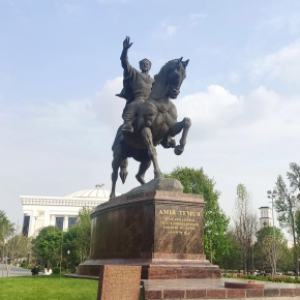An international Russian-Uzbek archaeological expedition will be established this year on the basis of Samara University and Samarkand State University. This structural association of Russian and Uzbek scientists will be engaged in scientific research under the international historical and archaeological project "Military campaign of Amir Timur in Desht-i-Kipchak in 1391." The relevant agreement was reached during a working trip of Samara archaeologists to the Republic of Uzbekistan.
"During a meeting with colleagues at Samarkand State University, the implementation of a pilot project to study the military campaign of the Central Asian Turkic ruler Amir Timur against the khan of the Golden Horde Tokhtamysh was discussed. We have agreed to establish an international Russian-Uzbek archaeological expedition this year, which will operate on the basis of Samara University. It is intended for conducting scientific research in Russia, as well as on the basis of Samarkand State University — for conducting research in Uzbekistan. The relevant protocol has been signed. The creation of this expedition will help in the development of our project by combining the efforts of scientists from different countries and regions, including archaeologists and historians from Uzbekistan, Kazakhstan, Tatarstan, Kurgan region, and Bashkiria. We will look for traces of that 1391 campaign along its entire route, study the landscape, check possible river crossings, look for remnants of earthen defensive structures and burial sites of soldiers killed in battle. In the Samara region, field archaeological work is scheduled to begin this summer, in August. Research in the Kurgan region and Bashkiria should also begin this year," said the scientific director of the Research Laboratory of Archeology at Samara University, Director of the Scientific and Educational Center of Archeology and Ethnography of the Volga region Sergey Zubov.
During the trip to Uzbekistan, Samara scientists also held meetings at the Samarkand Archaeological Institute named after Yahya Gulyamov, the State Museum of Timurid History, and the Shakhrisabz State Museum-Reserve. Earlier, the project was supported by the Scientific Research Institute for the Study of Cultural Heritage and Tourism Development under the Ministry of Culture and Tourism of the Republic of Uzbekistan. Scientists from the Alfred Khalikov Institute of Archaeology and the Shigabutdin Marjani Institute of History of the Academy of Sciences of Tatarstan, Kurgan State University and Ufa University of Science and Technology are participating in the project.
"The project is expanding, the number of its participants is growing. The military campaign of Amir Timur in 1391 in Desht-i-Kipchak has recently drawn increased attention from leading historians, archaeologists and many other relevant scientists and specialists in different countries, primarily in Russia, Uzbekistan, Kazakhstan, Azerbaijan, and Iran. There are positive results from studying this historical event in the scientific community. However, the routes of movement of troops have not yet been analyzed, the places of bivouacs and military camps have not been identified, the exact location of the general battle on Kondurcha and the routes of retreat of the Golden Horde detachments and their crossing of the Volga have not been localized. The main difficulty of the field research tasks in this project is the spacious search area. The competence of our university in terms of advanced technologies of laser and hyperspectral scanning and landscape analysis, with the help of which it will be possible to detect traces of hidden archaeological sites, will certainly help to solve this problem," said Sergey Zubov.
For reference:
* Desht-i-Kipchak (Polovitsan Steppe) is a historical region in Eurasia that constitutes a Great Steppe from the lower reaches of the Danube to the Irtysh River and the Balkhash Lake.
** In 1391, the Central Asian ruler Amir Timur went on a campaign against the khan of the Golden Horde, Tokhtamysh, who had previously launched a series of raids on Timur’s possessions. In June 1391, Timur’s army of 200,000 soldiers overtook the retreating Tokhtamysh in the territory of today’s Samara Region, and the famous battle took place, when the army of Tokhtamysh was defeated and the Khan himself fled. Four years later, Timur dealt a final blow to Tokhtamysh by defeating his army in a battle on the Terek River.
According to written sources of the period, the battle of 1391 took place in the area called Kunduzcha; this name is unanimously interpreted by historians as the Kondurcha River. The Kondurcha River is about 300 km long and the exact location of the battle remains unknown. Some scientists believe that the battle took place between the Sok River and the Kondurcha River, others — that it occurred near the village of Stary Buyan in the Krasnoyarsk District, others — that it happened near the village of Koshki, the name deriving from the Turkic word ‘kosh’ — ‘a camp of shepherds, a military camp.’ No physical evidence of the battle has yet been found.
According to most historians, the defeats of khan Tokhtamysh in the battles of 1391 and 1395 were fatal for the Golden Horde and marked its decline and the start of fatal destruction of its nationhood at the edge of the 14th and 15th centuries. Such a new political reality lay a foundation for reinforcement and ascent of the Grand Principality of Moscow over the rest Eastern-Slavic principalities which served as a prerequisite of establishment of the united Russian state in the future.
 RU
RU  EN
EN  CN
CN  ES
ES 